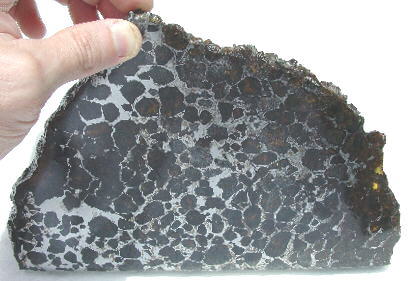Mount Vernon
PallasiteOne of two main classes of stony-iron meteorite, the other being mesosiderites. Pallasites are igneous in nature and characterized by crystals of olivine, sometimes peridot (green gem quality clear olivine crystals), embedded in a matrix of Fe-Ni metal. The type specimen, weighing 680 kg, was found in the mountains near Click on Term to Read More, PMG (main-group)
Found ~1868, recognized 1902
36° 56′ N., 87° 24′ W. A mass of 351 pounds was found on the farm of Capt. S. Fruit, about 7 miles northeast of Hopkinsville, Kentucky, but it was not recognized as a meteoriteWork in progress. A solid natural object reaching a planet’s surface from interplanetary space. Solid portion of a meteoroid that survives its fall to Earth, or some other body. Meteorites are classified as stony meteorites, iron meteorites, and stony-iron meteorites. These groups are further divided according to their mineralogy and Click on Term to Read More until 1902. During the intervening years, the owner had used the meteorite as a boot scraper, and had finally sent a sample to E. Ulrich, of the U.S. Geological Survey, but only when the increasing price of zinc and lead made him curious about its true nature. Mr. Ulrich subsequently acquired the specimen for the U.S. National Museum. The Catalogue of Meteorites fourth edition lists Mount Vernon as a fallMeteorite seen to fall. Such meteorites are usually collected soon after falling and are not affected by terrestrial weathering (Weathering = 0). Beginning in 2014 (date needs confirmation), the NomComm adopted the use of the terms "probable fall" and "confirmed fall" to provide better insight into the meteorite's history. If Click on Term to Read More during the year 1868, but this claim is in question. Only Marjalahti, Omolon, and Zaisho are undisputed pallasite falls.

Photo courtesy of the Dr. J. Piatek Collection







